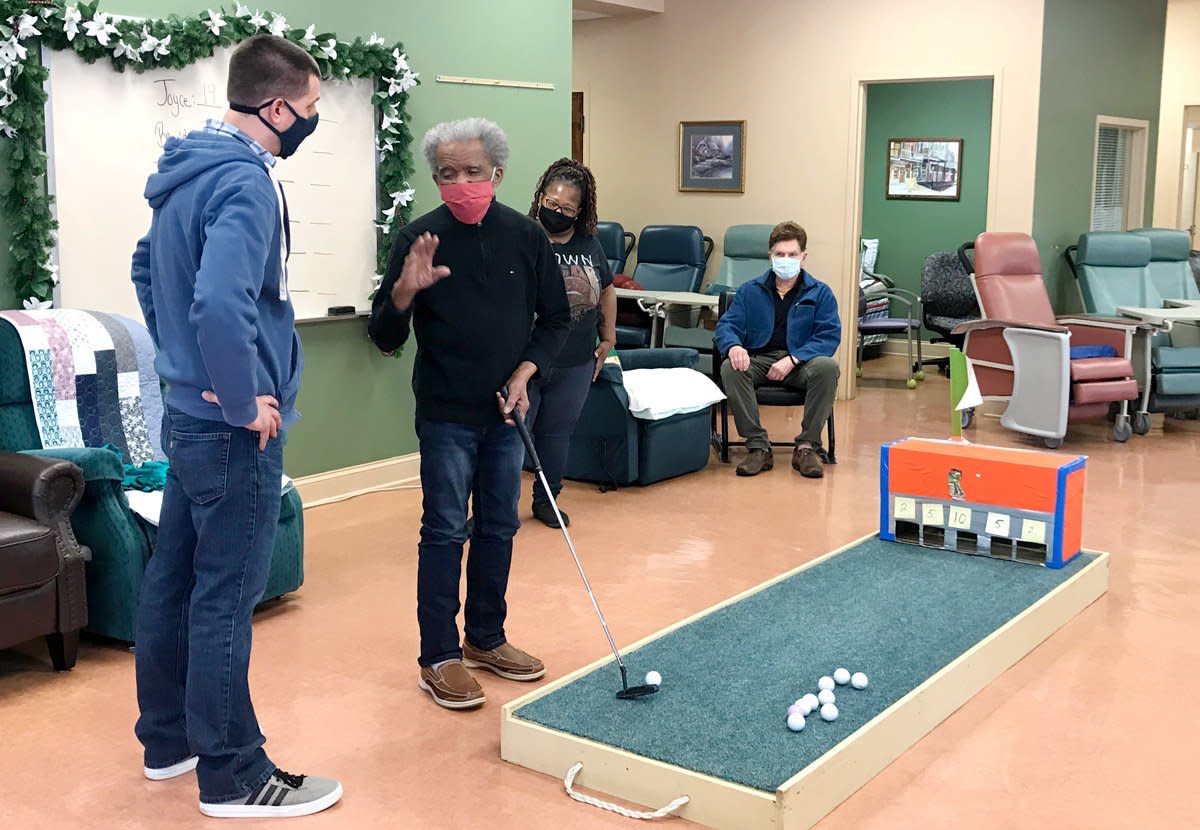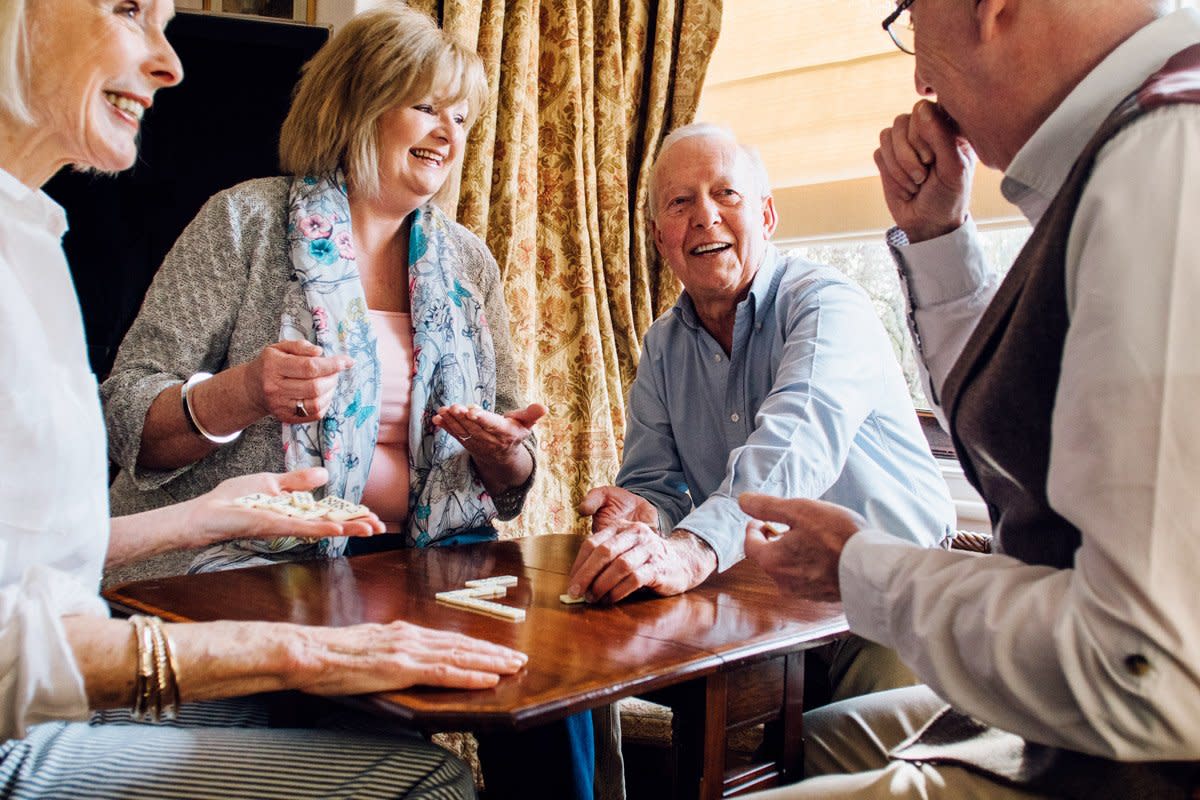Age at Home: How to Save Money on Senior Care
Many elderly people who require highly skilled nursing and watchful eyes around the clock have no choice but to live in a nursing facility. Others choose to move to one because of the socialization and ease of living with all meals and other services provided.
But most seniors would prefer to age in place, according to a 2018 AARP survey. It found 77% of Americans age 50 and older say they would like to remain in their current residence instead of moving somewhere else.
It’s not always possible, and certainly not easy to make this happen. Yet the benefits of a better adjusted, happier senior — along with saving thousands of dollars — make aging at home worth the effort.
How to Save Money Keeping Seniors at Home
Genworth, a Virginia-based provider of long-term care insurance, conducts an annual survey on the cost of care for retirees. The median price for one month in a private room in a nursing home in 2020 was $8,821. A semi-private room cost $7,756 a month. The average cost of a home health aide in the retiree’s home was $24 an hour.
With those daunting figures, family caregivers often think it makes sense to quit their jobs so they can devote themselves to caring for their seniors, and not pay for someone else to do the job.
Don’t do it, said financial journalist Jean Chatzky, who serves as an ambassador to AARP. She and others recently shared advice about caring for seniors during a webinar.
“The amount they would spend on care may be equal to the amount they would earn. But when you factor in all the other things, (such as) retirement contributions, Social Security credits, career trajectory, it makes sense to stay working,” Chatzky said.
Here are various options for keeping seniors in their homes and decreasing the costs of doing so.
Explore Adult Group Care Programs
Finding a great place for a senior to spend his or her days while a family member who’s also a caregiver works can enable the elder to stay in their home and the caregiver to stay employed.
Programs that provide group care for adults during the day can be the key to allowing a caregiver to continue working.
There is a range of options at various prices and levels of care where seniors can spend up to 10 hours a day with peers playing cognitive games, doing physical exercises, making crafts, having one or two meals and connecting with others.
To understand the benefits of a group day program for seniors versus a paid caregiver at home, consider the pros and cons of having a child in preschool versus at home with a nanny. The cost is less and there is more structure and socialization with a group.
There are several options for adult care programs outside the home:

Not-For-Profit Group Adult Care
Some churches and other non-profit organizations offer adult care programs five days a week for the whole day. While churches have offered pre-school programs for children for more than a century, Edenton Street United Methodist Church in Raleigh, N.C., was one of the first to develop an adult care program for seniors in 1991. The Ruth Sheets Center now cares for 25 seniors a day and is licensed for up to 32 when COVID-19 limits are lifted.
Ten hours of care costs $71, or about $7 an hour.
The program, which operates in the church’s fellowship hall, accepts seniors with varying degrees of physical and cognitive abilities. It’s okay if they have Alzheimer’s disease, are in a wheelchair or need assistance going to the bathroom.
“We do cognitive activities throughout the day. It might be as simple as naming the states, which can lead to a variety of different conversations. They might get to one state where somebody used to live or they often visited so this turns into an off-shoot conversation,” said Matt Frazier, Sheets Center executive director. “The whole key is to try to get everyone involved, to spark the mind.”
A typical day at the Sheets Center includes exercising, cognitive games, crafts, morning and afternoon snack, hot lunch and rest time. A Licensed Practical Nurse is on duty to help with clients who are insulin dependent (this costs a little extra) as well as any emergency health issues for all clients. Everyone on staff knows CPR and is certified as a Clinical Nursing Assistant or Patient Care Assistant.
They all understand the importance of keeping clients engaged, not just putting them in front of a movie, Frazier said.
When seniors make Valentines to send to family and friends, a caregiver gets people talking about past relationships or special people in their lives. During a horse racing game, seniors name each of their handheld miniature horses and explain why they chose that name.
“If someone has experience riding horses, or we have a staff member who has a fear of horses they can tell their stores,” Frazier said. “We make sure socialization goes along with the competition.”
For-Profit Adult Day Programs
There are numerous for-profit adult day programs. One is SarahCare, which has a wide range of activities based on clients’ abilities, according to Marcia Jarrel, executive director of the Lake Boone Trail program in Raleigh.
“Care plans are developed with the family and staff to help create meaningful and appropriate activities,” she said.
SarahCare has day programs for seniors in California, Connecticut, Florida, Georgia, Idaho, Indiana, Massachusetts, Michigan, New Jersey, North Carolina, Ohio, Pennsylvania and Texas. Prices vary but generally range from $60 for a 4-hour half day to $85 for an 11-hour full day, which includes breakfast, lunch and a snack.
SarahCare offers a wide variety of group and individualized activities. Each client plans their own custom day, which can include technology tutoring, letter writing, painting, bowling and close to 100 other things to do.
It also gets the community involved. High school students come to play Chess or other activities and the seniors themselves may go out to children’s daycare programs to rock babies or roll a ball with toddlers.
If family caregivers at home can’t shower seniors, that’s an option at SarahCare for $21. Transportation costs $14 one way and $28 round trip.
Visit the National Association of Area Agencies on Aging to find local agencies that can direct you to adult care programs in your area and financial programs that might help pay for them.

Check Out Local Community Centers
Many cities and counties have one or several senior centers offering classes, events, meals, camaraderie and other services at little or even no charge. Family caregivers can drop off their senior for several hours to give the elder an interesting outing and the caregiver a little time away.
This can be a valuable supplement to care at home several times a week for limited periods, but most senior centers do not offer continuous care throughout the day. Some, however, do have day-long programs. Clients need to be in good physical health and able to to follow programs on their own.
Important: Don’t Call It Daycare
No matter what you find for your senior to enjoy during the day, it can be insulting to a senior to refer to it as “daycare,” a term associated with little children. Frazier said his clients’ families say things such as, “You are going to your program today,” “going to see friends,” “going to church” or simply: “It’s time for the Sheets Center.”
DIY At-Home Senior Care
When their mother fell and broke her shoulder at age 89 three years ago, sisters Lynn Ellen and Donna Warren started a tag-team in-home care program that has only increased as their parents in Raleigh have gotten older. Two years ago, their father suffered a liver abscess that went undiagnosed and caused damage to his heart, kidneys and liver.
When he came home from the hospital, the two sisters learned to administer his IV and care for his abscess.
Both parents are better now but at ages 92 and 95, their health is deteriorating. Still, their daughters make it possible for them to remain in their own home without paying for any outside aid.
Ellen is local, so she spends about every other day with her mother and dad. Warren lives two hours away in Virginia and comes for five-day stints every three weeks, bringing lots of meals each time.
“Fortunately, we are both retired, and our children are grown. We decided we wanted to do this for them as long as we can,” Ellen said. “We are saving a ton of money and it’s what our parents prefer (over) moving into a place. They would go through so much money there very quickly.”
They’ve brought in limited outside help that’s covered by Medicare while learning several techniques for making home care easier and more affordable.
Free IV class
“The hardest medical stuff we had to figure out was when Daddy got discharged from Duke University Hospital. We had to keep him on the IV for the antibiotics,” Ellen said. The hospital gave them a free class and they didn’t leave until they really knew what they were doing.
Free therapy
Ellen’s mom has wet macular degeneration and her sight is very limited. Medicare completely covers an occupational therapist to help her continue daily functions. The therapist put bright dots on the switches of the toaster oven, microwave and washing machine so that they can be more easily operated.
“Medicare also provides other visual aids such as special lighting and an eye patch. The occupational therapist comes once a week for two hours to help Mom learn to do these things on her own for when we aren’t there,” Ellen said.
Meanwhile, her father’s primary doctor thought physical therapy could help his patient regain strength and improve his mobility. A physical therapist evaluated the situation and came for several weeks to teach a routine of leg lifts and arm exercises. The evaluation and actual therapy were completely covered by Medicare.
Free remote for visually impaired
Through the occupational therapist, Ellen learned their local cable company would give them an oversized remote with large buttons so her mom can now turn the TV on and off and change the channels and volume. Even if she can’t see it well, she can listen and get it going for her husband, who has limited mobility.
Lift chair
Another thing that helped was adding a “lift chair” to the home. These chairs include various reclining positions and a remote control that lifts up the chair and tilts it forward to help people with mobility issues go from sitting to standing. Prices start around $300.
Bathroom remodel
When Ellen and Warren decided to keep their parents at home as long as possible, they realized they needed to remodel their bathroom to make the door big enough for a wheelchair and get rid of the 6-inch ledge at the base of the shower door. There was extensive work required such as moving a wall and reworking plumbing.
“We made it all one level, added grab-bars and a fold-down seat in the shower,” Ellen said. The job was more than they expected, around $14,000.
“That is a lot of money, but that’s what a retirement home might charge for two people for just one or two months,” she said. “We did this three years ago and it has made it so much easier for all of us.”
FROM THE SAVE MONEY FORUM
Frequent Flyer Miles
6/1/21 @ 11:47 PM
How do you budget your money?
5/18/21 @ 3:09 PM
Saving for College
4/6/21 @ 5:13 PM
See more in Save Money or ask a money question
Look into Benefits for Veterans
The VA has a program called Veterans Aid and Attendance that provides a variety of services and money for veterans 65 and older who were honorably discharged.
Veterans with a net worth of no more than $129,094 may qualify for $2,170 or more per month toward the cost of several types of senior care, including nursing homes, memory care and adult day services.
Veterans who meet the above requirements are also eligible for financial help in modifying a bathroom so they can live at home with a disability or as they age. The lifetime benefit is $6,800 for eligible veterans with a service-connected disability, or $2,000 for veterans with non-service-connected disabilities.
Katherine Snow Smith is staff writer for The Penny Hoarder and author of Rules for the Southern Rulebreaker: Missteps & Lessons Learned.
This was originally published on The Penny Hoarder, which helps millions of readers worldwide earn and save money by sharing unique job opportunities, personal stories, freebies and more. The Inc. 5000 ranked The Penny Hoarder as the fastest-growing private media company in the U.S. in 2017.


